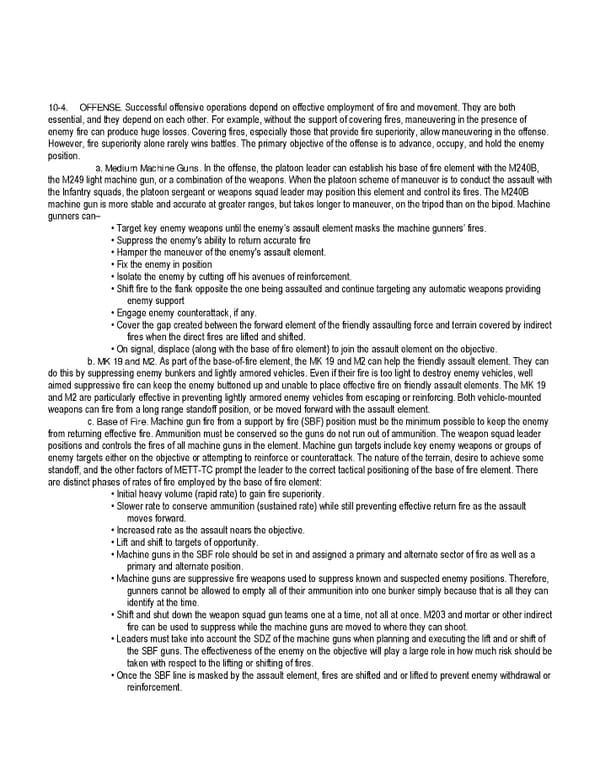10-4. OFFENSE. Successful offensive operations depend on effective employment of fire and movement. They are both essential, and they depend on each other. For example, without the support of covering fires, maneuvering in the presence of enemy fire can produce huge losses. Covering fires, especially those that provide fire superiority, allow maneuvering in the offense. However, fire superiority alone rarely wins battles. The primary objective of the offense is to advance, occupy, and hold the enemy position. a. Medium Machine Guns. In the offense, the platoon leader can establish his base of fire element with the M240B, the M249 light machine gun, or a combination of the weapons. When the platoon scheme of maneuver is to conduct the assault with the Infantry squads, the platoon sergeant or weapons squad leader may position this element and control its fires. The M240B machine gun is more stable and accurate at greater ranges, but takes longer to maneuver, on the tripod than on the bipod. Machine gunners can– • Target key enemy weapons until the enemy’s assault element masks the machine gunners’ fires. • Suppress the enemy's ability to return accurate fire • Hamper the maneuver of the enemy's assault element. • Fix the enemy in position • Isolate the enemy by cutting off his avenues of reinforcement. • Shift fire to the flank opposite the one being assaulted and continue targeting any automatic weapons providing enemy support • Engage enemy counterattack, if any. • Cover the gap created between the forward element of the friendly assaulting force and terrain covered by indirect fires when the direct fires are lifted and shifted. • On signal, displace (along with the base of fire element) to join the assault element on the objective. b. MK 19 and M2. As part of the base-of-fire element, the MK 19 and M2 can help the friendly assault element. They can do this by suppressing enemy bunkers and lightly armored vehicles. Even if their fire is too light to destroy enemy vehicles, well aimed suppressive fire can keep the enemy buttoned up and unable to place effective fire on friendly assault elements. The MK 19 and M2 are particularly effective in preventing lightly armored enemy vehicles from escaping or reinforcing. Both vehicle-mounted weapons can fire from a long range standoff position, or be moved forward with the assault element. c. Base of Fire. Machine gun fire from a support by fire (SBF) position must be the minimum possible to keep the enemy from returning effective fire. Ammunition must be conserved so the guns do not run out of ammunition. The weapon squad leader positions and controls the fires of all machine guns in the element. Machine gun targets include key enemy weapons or groups of enemy targets either on the objective or attempting to reinforce or counterattack. The nature of the terrain, desire to achieve some standoff, and the other factors of METT-TC prompt the leader to the correct tactical positioning of the base of fire element. There are distinct phases of rates of fire employed by the base of fire element: • Initial heavy volume (rapid rate) to gain fire superiority. • Slower rate to conserve ammunition (sustained rate) while still preventing effective return fire as the assault moves forward. • Increased rate as the assault nears the objective. • Lift and shift to targets of opportunity. • Machine guns in the SBF role should be set in and assigned a primary and alternate sector of fire as well as a primary and alternate position. • Machine guns are suppressive fire weapons used to suppress known and suspected enemy positions. Therefore, gunners cannot be allowed to empty all of their ammunition into one bunker simply because that is all they can identify at the time. • Shift and shut down the weapon squad gun teams one at a time, not all at once. M203 and mortar or other indirect fire can be used to suppress while the machine guns are moved to where they can shoot. • Leaders must take into account the SDZ of the machine guns when planning and executing the lift and or shift of the SBF guns. The effectiveness of the enemy on the objective will play a large role in how much risk should be taken with respect to the lifting or shifting of fires. • Once the SBF line is masked by the assault element, fires are shifted and or lifted to prevent enemy withdrawal or reinforcement.
 Ranger Handbook Page 203 Page 205
Ranger Handbook Page 203 Page 205